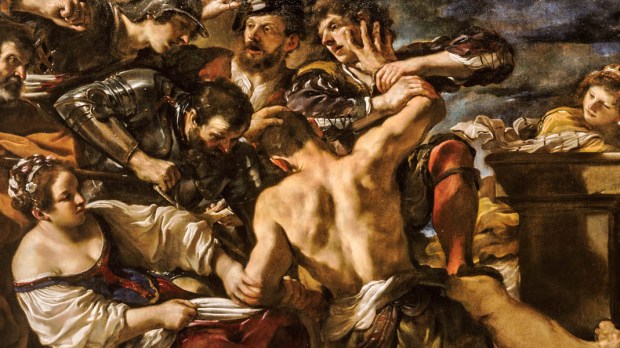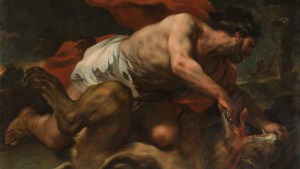A team of specialists led by Professor Jodi Magness, from the University of North Carolina at Chapel Hill, has uncovered a unique mosaic panel in the late Roman (ca. 400 A.D.) synagogue of Huqoq – an ancient Jewish village in Israel’s Lower Galilee.
According to the note published by Phys.org, Magness and Assistant Director Dennis Mizzi of the University of Malta focused on the south end of the synagogue’s main nave and discovered a large mosaic panel, “in the center of which is an enigmatic Hebrew inscription framed within a wreath. To the sides and below the wreath, an Aramaic inscription lists the names either of the donors who provided funding for the synagogue’s mosaics or the artists who made them, asking that they be remembered for good. The wreath is flanked on either side by lions resting their forepaws on bulls’ heads. The entire panel is surrounded by a decorated border showing animals of prey pursuing other animals.”
Additionally, the excavation exposed more sections of a series of panels that had already been discovered in 2012 and 2013, all dedicated to the story of Samson as read in the book of Judges. These newly discovered panels show the episodes of Samson and the foxes as mentioned in Judges 15:4 and Samson carrying the gate of Gaza on his shoulders referenced in Judges 16:3.
Samson in the Bible
Samson is quite a complex character. In popular culture, he is usually associated with brute strength, romantic betrayal, heroism — and even with nationalism. But core traits of this notorious biblical figure besides his legendary strength and long hair are relatively unknown to most.
Samson’s story is found in the book of Judges, chapters 13 to 16. It is generally believed to be a typical folk tale, aiming at the moral and spiritual edification of its listeners, very much à la Aesop. Some scholars claim Samson is the Israelite adaptation of typical Mediterranean heroes like the Greek Heracles or the Sumerian Enkidu — and some others consider the story has some elements of historical truth as well. Whether legendary or historical, most specialists agree the sources for the composition of the book of Judges were stories regarding the military prowess of tribal leaders who were able to deliver the people from different threats. These tribal leaders would receive the title of judges — hence the name of the book.
Samson himself was one of these judges. In fact, he was the last one, ruling the people right before the establishment of the monarchy. The original Hebrew for “judge” is shophet, literally meaning someone who is able to pass judgement — usually a prominent community leader who would play the role of chief magistrate, military leader, and ruler. In short, a kind of chieftain.
The biblical narrative is rather short. The book only dedicates three chapters to this story, presenting but very few episodes of his life, mainly related to the beginning and end of his 20 years as a judge. But those three chapters are more than enough. To begin with, they clearly hint at the tensions between Philistia and Israel during its early tribal period in Canaan. They also explain that Samson was given his great strength in order to aid him against his enemies — we find him slaying a lion with his bare hands, and decimating an entire Philistine army using only the jawbone of a donkey.
Christian readings of his story render Samson as a type of Jesus — that is, as a vetero-testamentary figure pre-figuring the Christ. Their stories can be somewhat similar. Both births were foretold by angels. Samson was born to a barren woman, and Jesus was born of a virgin. Samson defeated a lion, and Jesus defeated Satan — famously described in the first Epistle of Peter as a “roaring lion looking for someone to devour.” Delilah’s betrayal has typically been compared to that of Judas Iscariot — actually, both were paid in pieces of silver. And even some early medieval commentators saw Samson’s arms stretched between the two columns of the temple of Dagon as a kind of prefiguration of the crucifixion.



